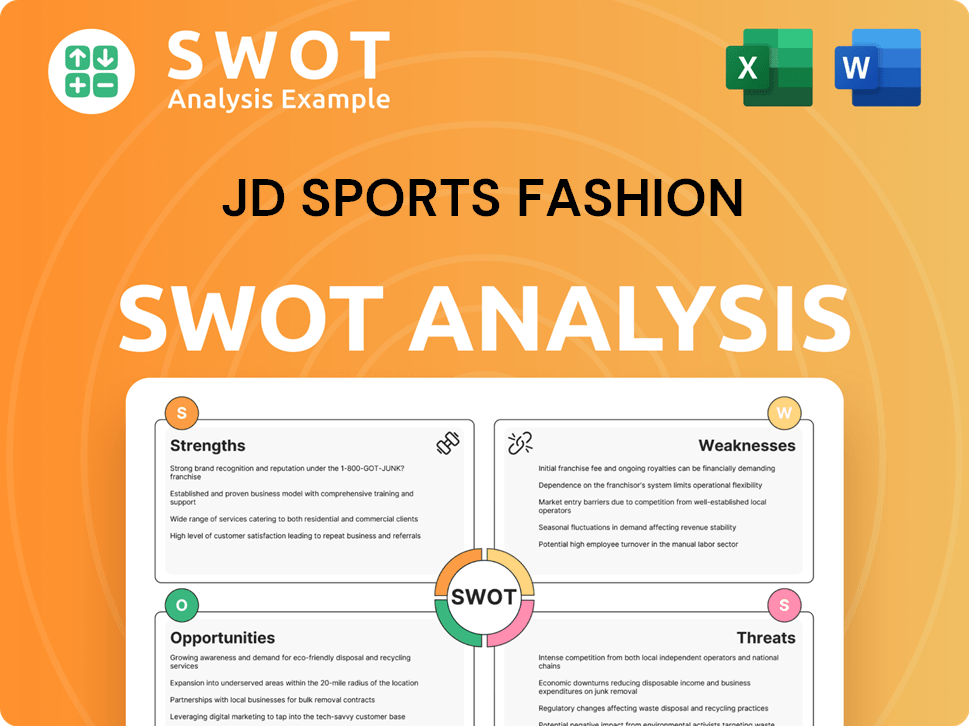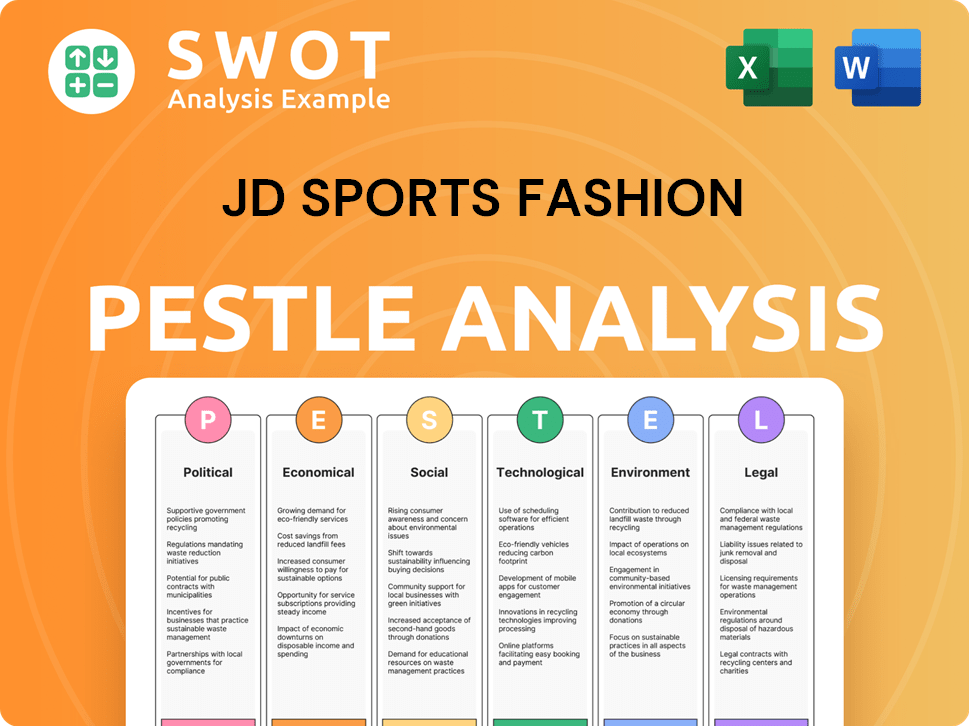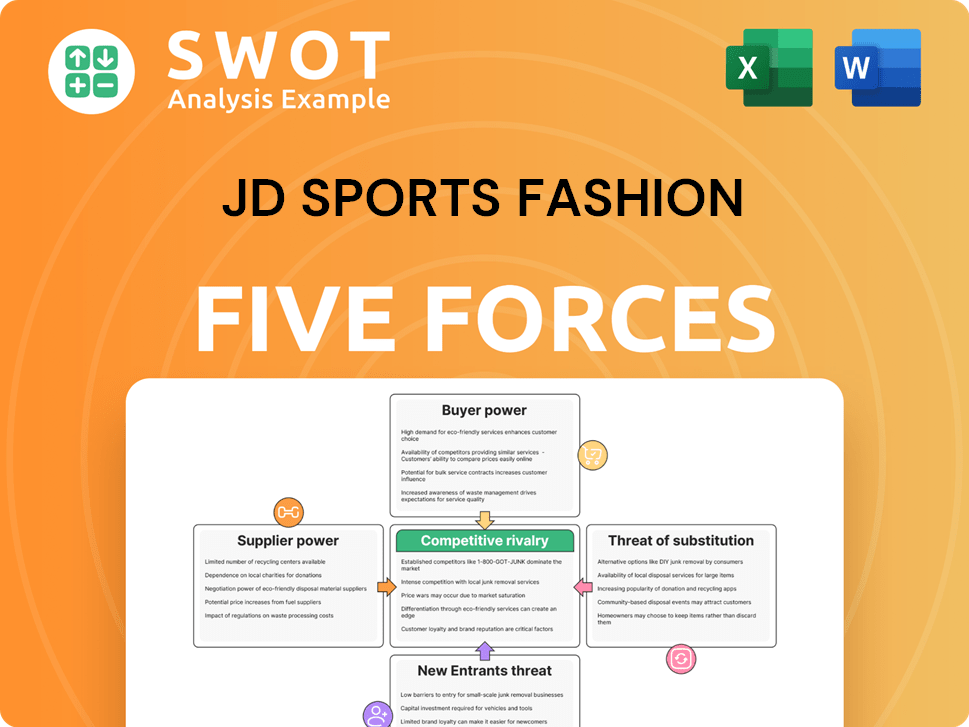JD Sports Fashion Bundle
Can JD Sports Maintain Its Reign in the Fashion Retail Arena?
JD Sports, the self-proclaimed 'King of Trainers,' faces a constantly shifting competitive landscape. From its humble beginnings in 1981, the company has exploded onto the global stage, boasting impressive financial figures and a vast retail network. This analysis delves into the core of JD Sports' competitive positioning, exploring its strengths, weaknesses, and the strategies that have fueled its remarkable growth.

Understanding the JD Sports Fashion SWOT Analysis is crucial to grasping its position within the sports apparel and fashion retail sectors. This exploration includes a detailed market analysis, examining industry trends and the company's financial performance. We'll dissect JD Sports' competitive advantages, its expansion strategy, and its online presence, providing insights into its future outlook and how it navigates challenges in the competitive landscape.
Where Does JD Sports Fashion’ Stand in the Current Market?
JD Sports Fashion Plc holds a prominent position in the sports fashion retail sector, particularly within the premium segment. The company's core operations revolve around the retail of branded sports and casual wear, including athletic footwear and apparel. A key element of its value proposition is targeting the 16-24 year old demographic, which makes up a significant portion of its customer base, approximately 50-65%.
The company's strategic focus involves offering a mix of international brands and own-brand merchandise. This approach, combined with a strong emphasis on digital transformation and omnichannel experiences, has allowed it to maintain a competitive edge. Furthermore, JD Sports is actively investing in infrastructure to support long-term growth, ensuring a seamless experience for its customers across various channels.
In FY25, JD Sports reported revenue of £11,458 million, a 10.2% increase over the comparative 52-week period, with constant currency revenue growth of 12.0%. This performance underscores its robust market position and ability to adapt to changing consumer preferences and market dynamics. For a deeper insight into their strategic approach, consider reading about the Growth Strategy of JD Sports Fashion.
JD Sports has demonstrated consistent organic sales growth, surpassing the estimated market value growth. In FY25, organic sales grew by 5.8%, outperforming the estimated market value growth of 3.8% in 2024. This indicates strong market share gains and effective execution of its growth strategies. The company continues to expand its global footprint.
JD Sports has successfully diversified its geographic presence, with North America becoming its largest region in FY25, generating 37% of revenue. Europe contributed 31%, the UK 28%, and Asia Pacific 4%. Strategic acquisitions, such as Hibbett and Courir, have further expanded its reach, adding approximately 10% to total revenue.
Despite a slight decrease in operating margin before adjusting items after interest on lease liabilities to 8.2% in FY25 from 9.0% in the prior period, JD Sports maintains a strong financial position. The gross margin for FY25 was 47.8%. The net cash balance at the period end (February 1, 2025) was £52 million, a decrease from £1,032 million in the prior year, primarily due to acquisitions.
JD Sports primarily focuses on branded sports and casual wear, including athletic footwear and apparel. Its strategy involves offering a 'premium' mix of international brands and own-brand merchandise. The company is investing in digital transformation to provide a seamless omnichannel experience. This approach supports its brand positioning and appeals to its target demographic.
JD Sports' market position is characterized by strong revenue growth, geographic diversification, and strategic acquisitions. The company's performance is driven by its focus on the premium sports fashion category and its ability to cater to the 16-24 year old demographic. The company's strategic acquisitions, such as Hibbett and Courir, have further expanded its footprint.
- Strong Revenue Growth: 10.2% increase in revenue in FY25.
- Geographic Expansion: North America is now the largest region.
- Strategic Acquisitions: Contributing to overall revenue growth.
- Digital Transformation: Investing in infrastructure for omnichannel experience.
JD Sports Fashion SWOT Analysis
- Complete SWOT Breakdown
- Fully Customizable
- Editable in Excel & Word
- Professional Formatting
- Investor-Ready Format

Who Are the Main Competitors Challenging JD Sports Fashion?
The Revenue Streams & Business Model of JD Sports Fashion operates within a highly competitive sports fashion retail market. Understanding the competitive landscape is critical for assessing its market position and future prospects. This involves analyzing both direct and indirect rivals, market dynamics, and emerging trends.
The sports apparel industry is vast and dynamic, with numerous players vying for market share. Analyzing these competitors helps in understanding the challenges and opportunities facing the company. This includes evaluating their strategies, market presence, and financial performance.
The competitive landscape for the company is multifaceted, encompassing global giants, domestic rivals, and online retailers. The sports apparel market was valued at approximately $175 billion in 2022, highlighting the scale of the competition.
Major global players like Nike, Adidas, and Puma are key direct competitors. These companies have strong brand recognition and extensive direct-to-consumer (DTC) channels. Nike, for example, generated $51.2 billion in revenue in 2022, showcasing the scale of the competition.
In the UK, the company faces strong competition from retailers such as Sports Direct (Frasers Group) and Foot Locker. Sports Direct achieved revenues of around $3 billion in 2022. The rivalry between the company and Frasers Group is particularly intense, extending into international markets and new categories.
The rise of online-only retailers such as ASOS and Boohoo has intensified competition. The UK online fashion market was valued at approximately $80 billion in 2022. Emerging DTC brands like Gymshark and Allbirds also challenge established retailers.
The company's market share in the UK sportswear market was reported to be 22% in 2023, down from 36% in 2019. This decline reflects increased competition and slower e-commerce adaptation. Despite this, it remains a significant player in the market.
Major fashion brands are increasingly introducing sportswear lines to capitalize on the athleisure trend. Nike and Adidas reported that their sportswear lines contributed over 30% of their total revenue in 2023, increasing competitive pressure. This diversification adds another layer of competition.
Mergers and acquisitions also impact the competitive dynamics. The Competition and Markets Authority (CMA) found that the company's acquisition of Footasylum in 2019 would result in a substantial lessening of competition, requiring divestment. This highlights the regulatory scrutiny in the industry.
Several factors drive competition in the sports fashion retail market, including brand recognition, pricing strategies, online presence, and supply chain efficiency. Understanding these factors is crucial for assessing the company's competitive advantages and disadvantages. The company's ability to adapt to changing consumer preferences and market trends is also critical.
- Brand Recognition: Strong brand reputation and consumer loyalty are essential.
- Pricing Strategies: Competitive pricing and promotional activities impact sales.
- Online Presence: Effective e-commerce platforms and digital marketing are vital.
- Supply Chain Efficiency: Efficient supply chains ensure product availability and reduce costs.
- Market Trends: Adapting to athleisure and other fashion trends is important.
JD Sports Fashion PESTLE Analysis
- Covers All 6 PESTLE Categories
- No Research Needed – Save Hours of Work
- Built by Experts, Trusted by Consultants
- Instant Download, Ready to Use
- 100% Editable, Fully Customizable

What Gives JD Sports Fashion a Competitive Edge Over Its Rivals?
The competitive landscape for JD Sports Fashion Plc is shaped by its strategic moves, including significant acquisitions and expansion efforts. These actions, coupled with its strong brand presence and operational capabilities, have positioned it as a key player in the fashion retail sector. The company's focus on enhancing its omnichannel approach and leveraging its extensive store network further strengthens its market position.
JD Sports' competitive edge is defined by its ability to cultivate brand loyalty and maintain a strong customer base, especially among the 16-24 age group. Its strategic partnerships with major brands and exclusive product offerings contribute to its ability to maintain high margins and attract customers. By continually investing in technology and operational improvements, JD Sports aims to stay ahead of industry trends and enhance its overall performance.
A detailed market analysis of JD Sports Fashion reveals its competitive advantages. The company's strengths include its extensive store network, strong brand equity, and robust supply chain. These elements, combined with its strategic acquisitions and omnichannel approach, contribute to its sustained success in the sports apparel market.
JD Sports operates a vast network of stores globally, with approximately 4,871 stores worldwide as of May 3, 2025. This extensive physical presence is complemented by strong e-commerce platforms. This omnichannel strategy enhances brand visibility and customer accessibility.
JD Sports has cultivated a strong brand presence, particularly among its target demographic of 16-24 year olds. The company offers a premium mix of international brands and exclusive product releases. This strategy helps in avoiding margin erosion.
JD Sports invests in technology to enhance in-store experiences and expand online offerings. The company's global distribution network and supply chain strengths are considered rare in the sports fashion retail space.
Strong relationships with key brand partners like Nike and Adidas provide preferential access to exclusive products. JD Sports benefits from a strong talent pool and invests in training and employee development. The company is recognized as Nike's number one global partner.
JD Sports' competitive advantages include its expansive store network, strong brand equity, and strategic partnerships. The company's ability to efficiently operate thousands of stores globally and its strong relationships with key brands provide a significant edge in the competitive landscape. These factors contribute to JD Sports' sustained success in the sports apparel market.
- Extensive Store Network: A global presence with approximately 4,871 stores.
- Strong Brand Equity: Known for offering a premium mix of international brands and exclusive products.
- Strategic Partnerships: Preferential access to exclusive products from key brands like Nike and Adidas.
- Omnichannel Approach: Combining physical stores with robust e-commerce platforms for enhanced customer engagement.
JD Sports Fashion Business Model Canvas
- Complete 9-Block Business Model Canvas
- Effortlessly Communicate Your Business Strategy
- Investor-Ready BMC Format
- 100% Editable and Customizable
- Clear and Structured Layout

What Industry Trends Are Reshaping JD Sports Fashion’s Competitive Landscape?
The competitive landscape for JD Sports within the fashion retail sector is dynamic, shaped by evolving industry trends and the company's strategic responses. A deep dive into market analysis reveals that the sports apparel market is experiencing significant growth, presenting both opportunities and challenges for JD Sports. Understanding these factors is crucial for assessing the company's future outlook and competitive position.
The sports apparel and footwear market is projected to grow at 6.6% annually over the next 5-7 years, driven by consumer preferences for lifestyle apparel and footwear. However, JD Sports faces risks from potential US tariff changes, especially given its significant presence in North America, its largest region by sales, and the volatility expected in key markets. The company's strategic plan, launched in February 2023, focuses on growth and efficiency, aiming for double-digit revenue growth and market share gains.
The sportswear market is on a long-term growth trajectory, fueled by consumer demand for athletic and lifestyle apparel. Digital transformation continues to be a major trend, with consumers increasingly seeking immersive in-store experiences alongside robust online offerings. Social media's influence on purchasing decisions is also rising, impacting the fashion retail sector.
Potential US tariff changes could significantly impact costs, especially given manufacturing in regions targeted by tariffs. Volatility in key markets is expected, with like-for-like revenues predicted to fall short of FY25 levels. Intense competition and price wars continue to pressure profit margins, while declining demand in certain areas poses a challenge.
The strategic plan launched in February 2023 focuses on growth in North America and Europe. The company plans to open 200-250 new stores annually. Optimizing supply chains and leveraging partnerships, such as the 'connected partnership' with Nike, are expected to boost profitability and market share.
JD Sports has a strong brand presence and a focus on strategic partnerships. The company is refining its approach in Europe and expanding its footprint. The shift from aggressive expansion to cash generation is expected to strengthen the balance sheet and increase shareholder payouts.
The company's strategic plan includes a focus on four key pillars: JD Brand First, Complementary Concepts, Beyond Physical Retail, and People, Partners and Communities. This strategy aims to unlock organic growth opportunities, particularly in North America and Europe, and drive efficiency gains. The company's approach to supply chain optimization is a key element in boosting profitability.
- The global sportswear market is expected to grow by 6.6% per annum over the next 5-7 years.
- JD Sports plans to open 200-250 new stores annually.
- The company is refining its approach in Europe, leveraging its strong position in France through the Courir acquisition.
- Strategic partnerships, such as its 'connected partnership' with Nike, reinforce its market importance.
For a deeper understanding of how JD Sports is navigating its growth, you can read about Growth Strategy of JD Sports Fashion. This article provides additional insights into the company's strategic initiatives and market positioning.
JD Sports Fashion Porter's Five Forces Analysis
- Covers All 5 Competitive Forces in Detail
- Structured for Consultants, Students, and Founders
- 100% Editable in Microsoft Word & Excel
- Instant Digital Download – Use Immediately
- Compatible with Mac & PC – Fully Unlocked

Related Blogs
- What are Mission Vision & Core Values of JD Sports Fashion Company?
- What is Growth Strategy and Future Prospects of JD Sports Fashion Company?
- How Does JD Sports Fashion Company Work?
- What is Sales and Marketing Strategy of JD Sports Fashion Company?
- What is Brief History of JD Sports Fashion Company?
- Who Owns JD Sports Fashion Company?
- What is Customer Demographics and Target Market of JD Sports Fashion Company?
Disclaimer
All information, articles, and product details provided on this website are for general informational and educational purposes only. We do not claim any ownership over, nor do we intend to infringe upon, any trademarks, copyrights, logos, brand names, or other intellectual property mentioned or depicted on this site. Such intellectual property remains the property of its respective owners, and any references here are made solely for identification or informational purposes, without implying any affiliation, endorsement, or partnership.
We make no representations or warranties, express or implied, regarding the accuracy, completeness, or suitability of any content or products presented. Nothing on this website should be construed as legal, tax, investment, financial, medical, or other professional advice. In addition, no part of this site—including articles or product references—constitutes a solicitation, recommendation, endorsement, advertisement, or offer to buy or sell any securities, franchises, or other financial instruments, particularly in jurisdictions where such activity would be unlawful.
All content is of a general nature and may not address the specific circumstances of any individual or entity. It is not a substitute for professional advice or services. Any actions you take based on the information provided here are strictly at your own risk. You accept full responsibility for any decisions or outcomes arising from your use of this website and agree to release us from any liability in connection with your use of, or reliance upon, the content or products found herein.